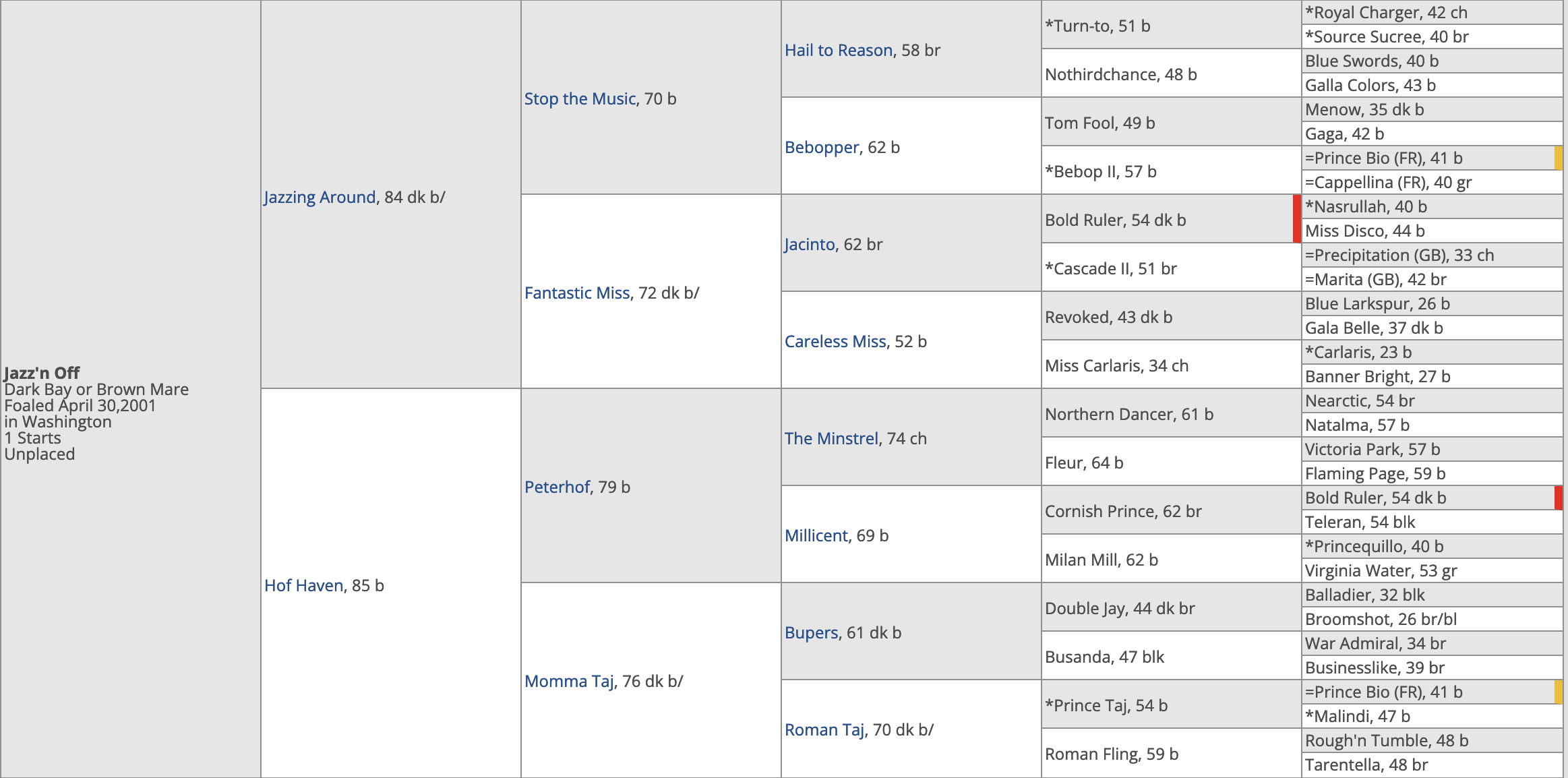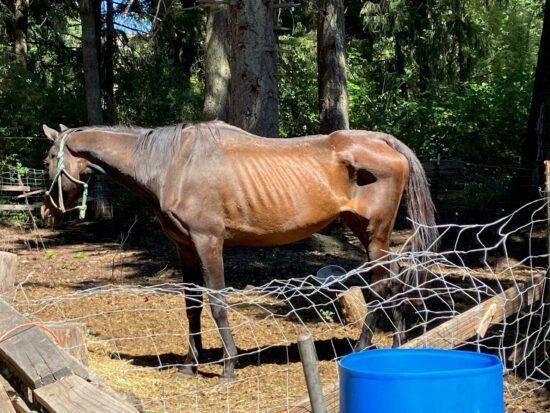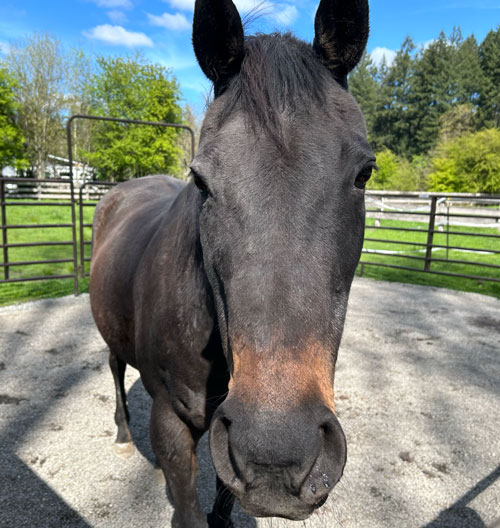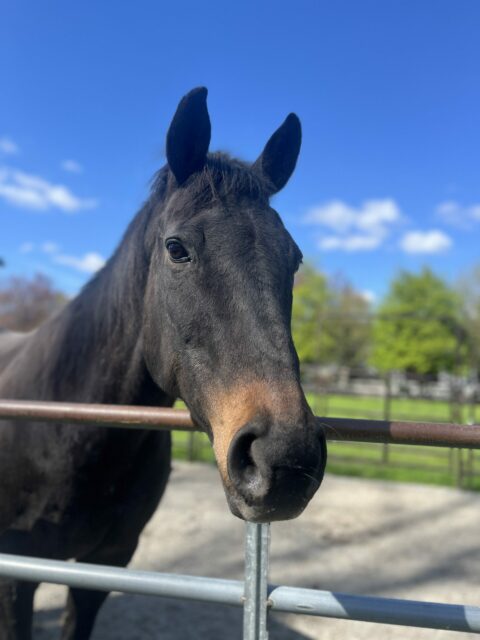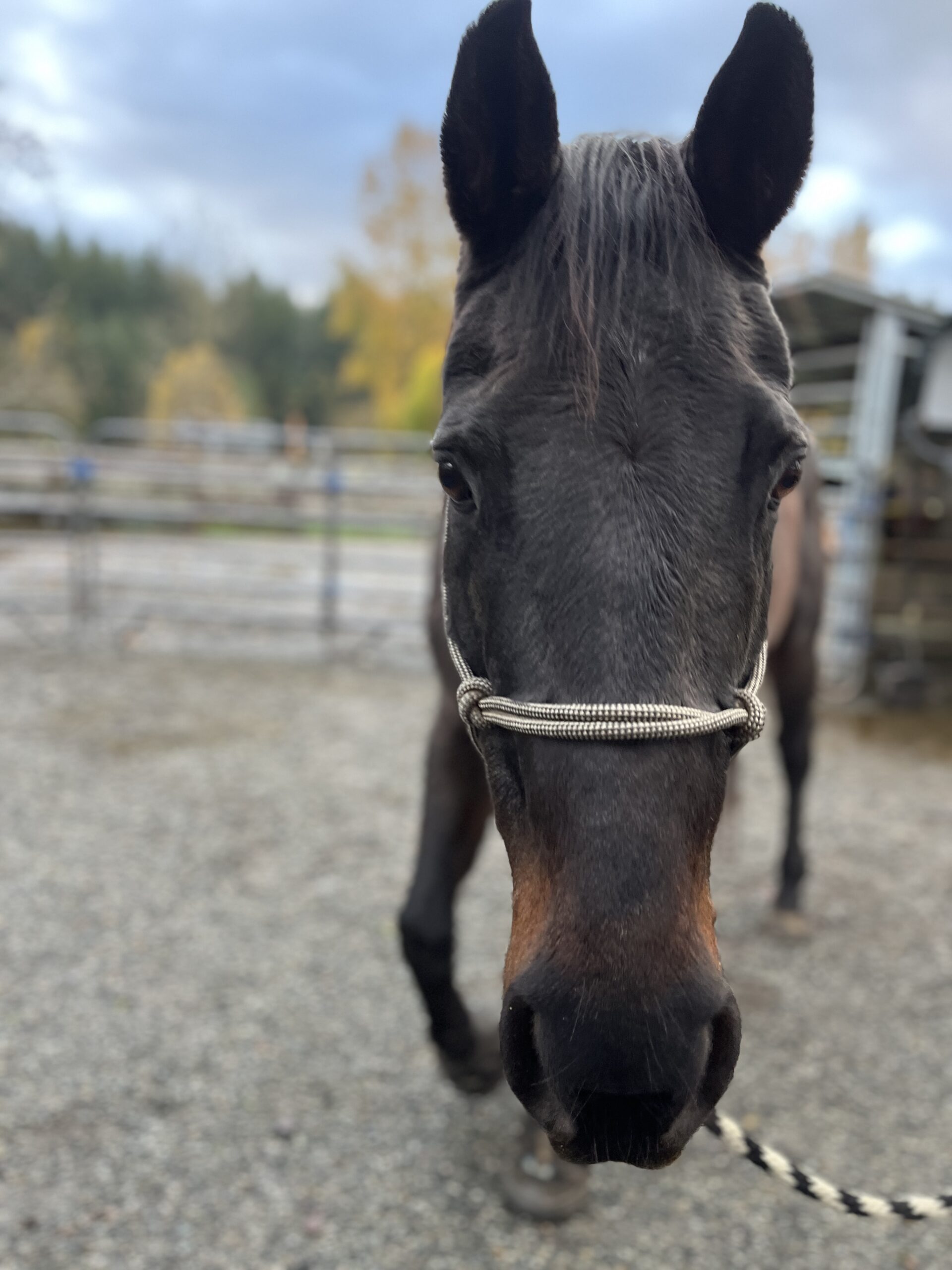Dorothy
2001 Dark Bay Thoroughbred Mare
Type of Rescue: Animal Control Surrender
Intake Date: 11/6/2023
Date Deceased: 4/13/2024
Length of Time with SAFE: 5 months
Dorothy came to SAFE after being seized several months earlier by Pierce County Animal Control. She was an older Thoroughbred mare with a body condition score of 2 upon seizure and had a myriad of other health issues that were in need of attention. By the time she arrived at SAFE from where she had been under foster care, she was in better shape, but still not completely healthy.
Dorothy didn’t deserve to be defined by the neglect she suffered before coming to SAFE. But the truth is, she lived through some severe hardship. When she came to SAFE, she was recovering from a bad UTI and she was still in need of calories to hit her ideal body condition. Years of neglect had left her teeth unable to manage dry hay without the risk of choking. Her most pressing health issue lay with her feet. She had deep abscess tracks in her front hooves that made movement very painful.
Five months in our care had returned her good health in many ways, but there were still lingering issues that cause her discomfort and pain. Daily pain medication and soft-ride boots kept her comfortable, and a mash diet that she could consume easily helped her put on more weight. But we knew that Dorothy’s time was coming. We promised to watch over her and her quality of life carefully. As long she continued to have good days, she would stay with us.
Dorothy’s final day started well, but by early evening, she was deeply distressed, sweating, swinging her head up and down, and grinding her teeth. Our vet came out, and even sedation couldn’t calm her down. She was in pain. Maybe it was colic, maybe ulcers, maybe something else entirely. But with a DNR in place, we decided it was time to let her go. So, just as the crescent moon rose over the horizon, Dorothy left this world. Her passing was peaceful, quiet, and dignified.
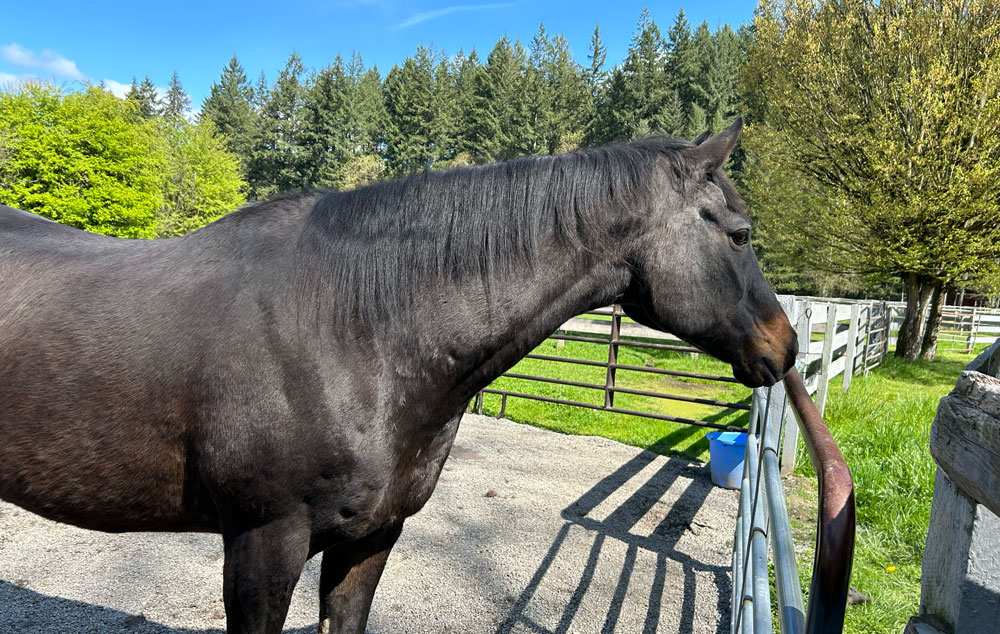
Watch Over Me
Horses come to us for different reasons. For many, it’s a first step toward a new and better life. Others get their chance for some much needed peace and caring, and a chance for us to rewrite their final chapter. Dorothy is one such horse.
Dorothy is a beauty of a mare who doesn’t deserve to be defined by the neglect she suffered before coming to SAFE. But the truth is, she’s lived through some severe hardship. Five months in our care has returned her health in many ways, but there are still lingering issues that cause her discomfort and pain.
Dorothy placed her trust in us, and in return we promised to watch over her and her quality of life. As long she continued to have good days, she would stay with us.
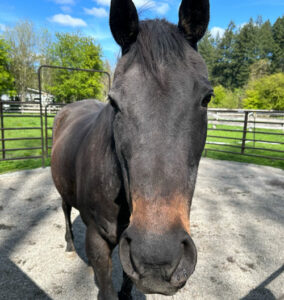 Saturday started as a good day. Dorothy enjoyed a bodywork session in the morning that left her calm, relaxed, and happy. Which is why it was such a shock in the afternoon when she became intensely anxious, running back and forth in her paddock, seemingly unaware of her surroundings. She worked up a lather of sweat over her entire body, tossed her head up and down, grinding her teeth. It was perplexing and alarming, and it seemed almost like she was trying to tell us something.
Saturday started as a good day. Dorothy enjoyed a bodywork session in the morning that left her calm, relaxed, and happy. Which is why it was such a shock in the afternoon when she became intensely anxious, running back and forth in her paddock, seemingly unaware of her surroundings. She worked up a lather of sweat over her entire body, tossed her head up and down, grinding her teeth. It was perplexing and alarming, and it seemed almost like she was trying to tell us something.
We tried to calm her by bringing her back to her paddock near Roy and Mirana, and giving her alfalfa leaves to enjoy, but her anxious behavior continued. Our vet suggested giving her a dose of Trazadone might help her relax, but she wouldn’t take more than a couple of bites of the mash it was crushed in. When the vet arrived to examine her, she was given a sedative, but it did little to settle her down. Clearly something was causing her a lot of pain. Maybe it was colic, maybe ulcers, maybe something else.
Or maybe Dorothy was making a difficult decision a tiny bit easier for the people who cared for her. Our girl had signed a DNR, and we chose to honor it. So last night, just as the crescent moon rose over the horizon, Dorothy left this world. Her passing was peaceful, quiet, and dignified.
I want to thank Trudy for everything she did for Dorothy yesterday. She tried everything possible to make Dorothy comfortable, she stayed late to meet the vet, and she stayed by Dorothy’s side until the end. Her kindness helped Dorothy a great deal, and I am very grateful that she was there last night. I also want to thank Candi for arranging Dorothy’s Masterson session, which made her last day gentle and wonderful. And I want to thank Dorothy’s friend Carrie who came out on Friday to spend time with her and groom her and make her shine. Carrie also took these pictures so we can remember Dorothy on a very good day.
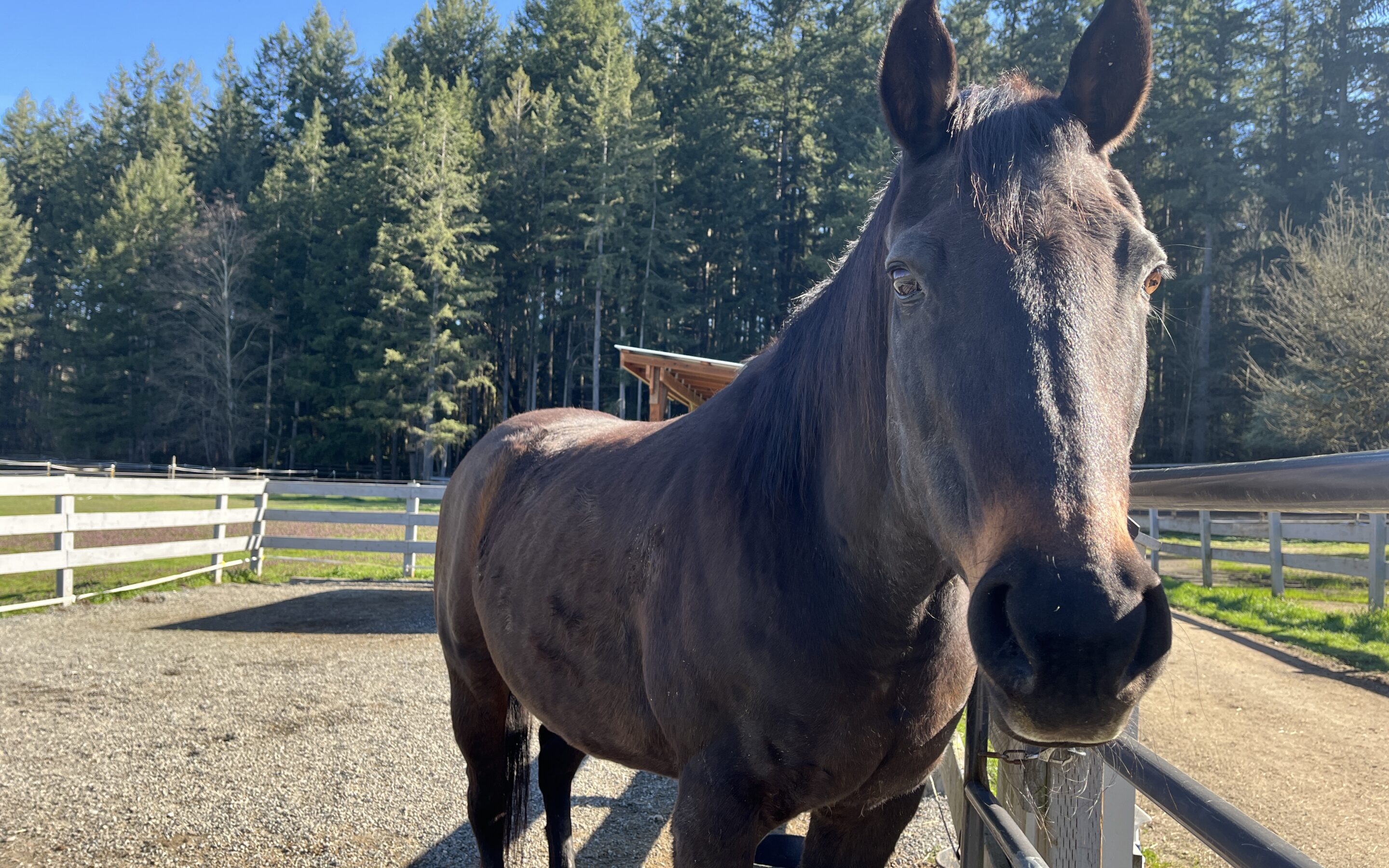
Dorothy Health Update
Dorothy came to SAFE from Pierce County Animal Control after being seized from a neglectful situation. PCAC does a tremendous job of vetting and rehabbing the horses that come into their care before they even come to SAFE, but Dorothy came to us still in need of a significant amount of TLC, which speaks to the gravity of her initial situation. She was recovering from a bad UTI that had led to caslick’s being placed, and while she was a much healthier weight, she was still in need of calories to hit her ideal body condition. Upon intake to PCAC, Dorothy experienced a colic episode attributed to poor teeth, resulting in her being placed on a mash-only diet. Years of neglect had left her teeth unable to safely manage dry hay without the risk of choking. However, her most pressing health issue lay with her feet.
Thoroughbreds are not known for having great feet – they tend towards thin soles as a rule, and Dorothy is no exception to this. She was dealing with the fallout of some pretty horrendous abscessing upon arrival, with deep abscess tracks on both front feet that were making movement very painful. We got Dorothy outfitted in boots, and thankfully our farrier was able to come out within the week to assess her hooves and give her a trim. Her opinion, which mirrored ours, was that the condition of Dorothy’s feet was very poor – the abscess tracks had left what were essentially portals to live tissue in her hooves, signs that this would be a lengthy and difficult healing process. Her suggestion, which we took, was to cover Dorothy’s soles with the antimicrobial Artimud and keep her hooves booted 24/7. In addition, we would also try to bring Dorothy into a stall at night to help mitigate risk of her hooves being in the continual wet environment of a PNW winter. Even the best boots are not infallible.
Unfortunately, in addition to her physical issues, Dorothy suffers from extreme anxieties that complicate her experiences, such as being in a stall. It became evident from the outset that she suffers from intense stall anxiety. Despite our efforts to ease her transition into the stall at SAFE — staying nearby to prevent self-harm, providing visual access to her companions through opened windows, and offering food for distraction — Dorothy remained inconsolable. Even after ceasing her pacing and somewhat settling, she continued to display signs of extreme anxiety, including frantic mouth movements and head bobbing. Despite repeated attempts to bring her inside, Dorothy’s distress persisted. Instead of continuing on this route, we instead prioritized her comfort, resolving to address her hoof issues while allowing her to reside outdoors where she feels most at ease.
As an offshoot to her general anxiety, Dorothy is extremely herdbound. This can be a challenging issue to combat even in young, healthy horses, and seeing as Dorothy is neither of those things, we did not feel it would be fair to her to put her through a ‘divorce’ like we might do in other circumstances. Even simple alterations to her routine negatively impacted her eating habits, highlighting the delicate balance required to manage her well-being. When any change occurs it takes her several days to eat consistently again, even when coaxed with different grain varieties. It is clear that any kind of change is difficult for Dorothy to handle, even when we do our best to control the surrounding circumstances. In order to keep her comfortable, we had to place her in a location where her friend/neighbor was likely to stay put.
Despite ongoing efforts, Dorothy’s hoof issues persisted, necessitating long-term pain management strategies. In the boots, Dorothy’s feet were at least protected and given a fighting chance to heal, but even with the inches of padded support, she was still unsound. We had our vet out to evaluate Dorothy, where she observed the extent of her lameness and discomfort. She also took a look at the radiographs that Pierce County had taken of Dorothy’s front feet, which showed significant changes/remodeling of her coffin bones.
To alleviate Dorothy’s pain, our vet recommended a dosage of Bute supplemented with Tylenol. While this medication offers temporary relief, relying on a strong NSAID like Bute for an extended period can have adverse effects on her health. Despite this, we’re consoled that the medication has brought her some comfort, allowing her to walk without constant pain for the time being.
Several trim cycles have come and gone, and while Dorothy’s feet have improved, it is our farrier’s opinion that to take her out of the boots would compromise the foot we have worked so hard to heal and strengthen. To pull Dorothy out of the boots, even on soft ground, would put her at risk for a potential backslide, and it does not seem worth it to us, or fair to her, to risk that.
The harsh truth is, considering all factors, we’re compelled to question Dorothy’s quality of life. While it’s heartening to see her now, at a healthy weight, moving comfortably with the aid of medications, and acknowledging her improvement since our initial encounter (and certainly since her rescue), several challenges persist, preventing Dorothy from enjoying a full and comfortable life. While we strive to provide the best care possible for horses like Dorothy, we must also weigh the long-term implications and make decisions in their best interest.
Considering Dorothy’s myriad of health issues coupled with her anxious disposition, it became apparent that she would likely remain at SAFE indefinitely. As caretakers, it falls upon us to ensure she lives out her days with comfort and dignity. As spring approaches and environmental conditions improve, we plan to introduce Dorothy to a pasture environment, allowing her to enjoy a semblance of normalcy despite her ongoing health challenges.
Dorothy’s journey serves as a reminder of the complexities involved in rehabilitating neglected animals. While her progress has been significant, her ongoing needs highlight the importance of responsible stewardship and compassionate care.
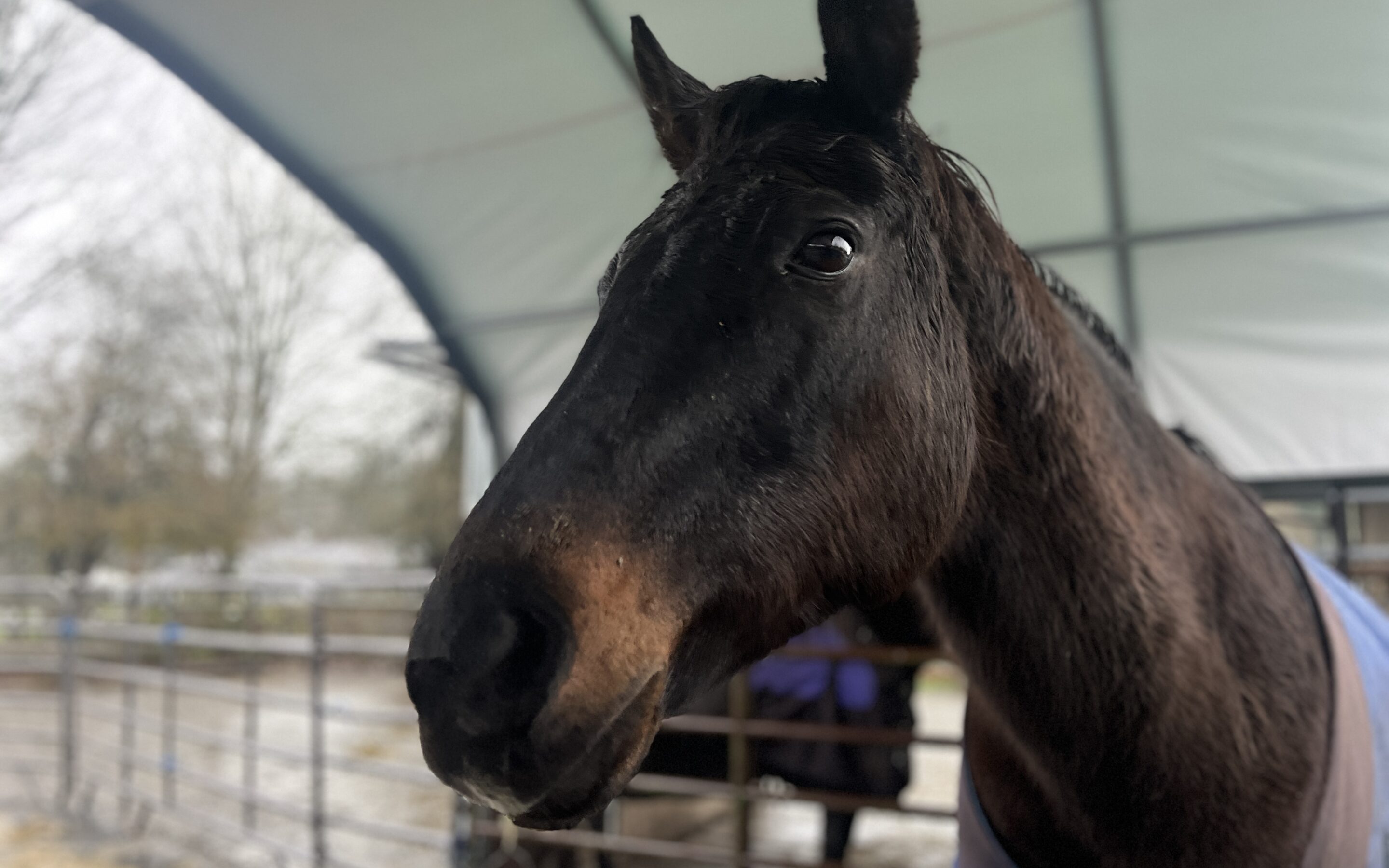
Dorothy’s Family Tree
Dorothy has no white markings. Her coat is comprised of a spectrum of browns, ones that Pantone labels as ‘shaved chocolate’ and ‘molé’ and ‘ganache’ — rich, chocolatey adjectives. However, if you were to curl up her top lip, you would find the mark that humans have left on Dorothy, a faded, blown-out tattoo that identifies her as a race horse.
The legibility of thoroughbred tattoos varies. In Dorothy’s case, we pored over the photo we were able to snap with the intensity of forensic scientists. Could that number be a 4, or was it a 9? Was the 6 a 5 or the 5 a 6? Why was 6 afraid of 7? Because 789! But with the information we could glean, alongside some careful guesswork, we pieced together who Dorothy was before she was Dorothy.
Each horse has a history, but more often than not, their records lie in the memories of those humans they’ve come in contact with. For some, there exist photos, maybe videos. Show ribbons, a brass nameplate. A chewed-on fenceboard, a bent panel. It is no secret that more often than not, horses arrive to us from negligent or abusive situations, but they have left their mark in one way or another, just as they have had marks left on them. But while we can invent histories for hours upon end, glean information from how a horse behaves or from physical marks that may be present, there is often very little factual data about who they were before us.
Having a thoroughbred registry to pull from, in Dorothy’s case, changes that.
Plugging in her tattoo reveals her registered name — Jazz’n Off — and plugging in her name reveals her pedigree, a sprawling family tree neatly condensed into a single rectangle. On her dam’s side, she’s got big names like War Admiral and Northern Dancer (and surely more who are more easily identifiable to someone who knows more than just the AA-listers off the top of my head). Attached to each of these little sans-serif names is a history. Some hold entire Wikipedia pages, some direct you to a lovingly tended memorial site, others to a short-form biography, or a page listing stats: starts, wins, losses, earnings. The mark that thoroughbreds leave is often defined by numbers — most notably those beginning in a dollar sign — but each one of Dorothy’s relatives was once a living breathing creature, and just as they left their mark on the racing world (however large or small that might have been), they also left their mark on Dorothy. The color of her coat, her kind demeanor, and, yes, her poor feet, all a result of (or at least influenced by) those who came before her. Every horse has a family tree, but it is so fascinating and such a gift to be able to see exactly what that tree looks like.
Dorothy herself, as ‘Jazz’n Off’ was born in April of 2001. She ran in one race at Emerald Downs in the spring of 2004, but did not see the finish line, as she grew tired after a quick start and was subsequently distanced to the rail.
Dorothy has three full siblings: Jazz Heaven, Jazz Haven, and Jaded Jazz. Jazz Haven was the most successful of the bunch, having several wins and multiple other high placements, earning him nearly 61,000 over the course of his career. Jaded Jazz saw mild success with career earnings just shy of 18,500, with two wins, both in Canada. Jazz Heaven has an Australian name twin who makes it difficult to find much information on him.
Some other interesting individuals in Dorothy’s family are Princequillo and Sir Gallahad both of whom traveled overseas via ship (Princequillo from France to Ireland, and then to New Orleans, and Sir Gallahad from London to New York). Surely there are more seafaring members of her family, but these two went on to have more impressive histories than most.
Dorothy’s legacy may not be in the races she won or the distance she traveled, but rather in the lives she touched.
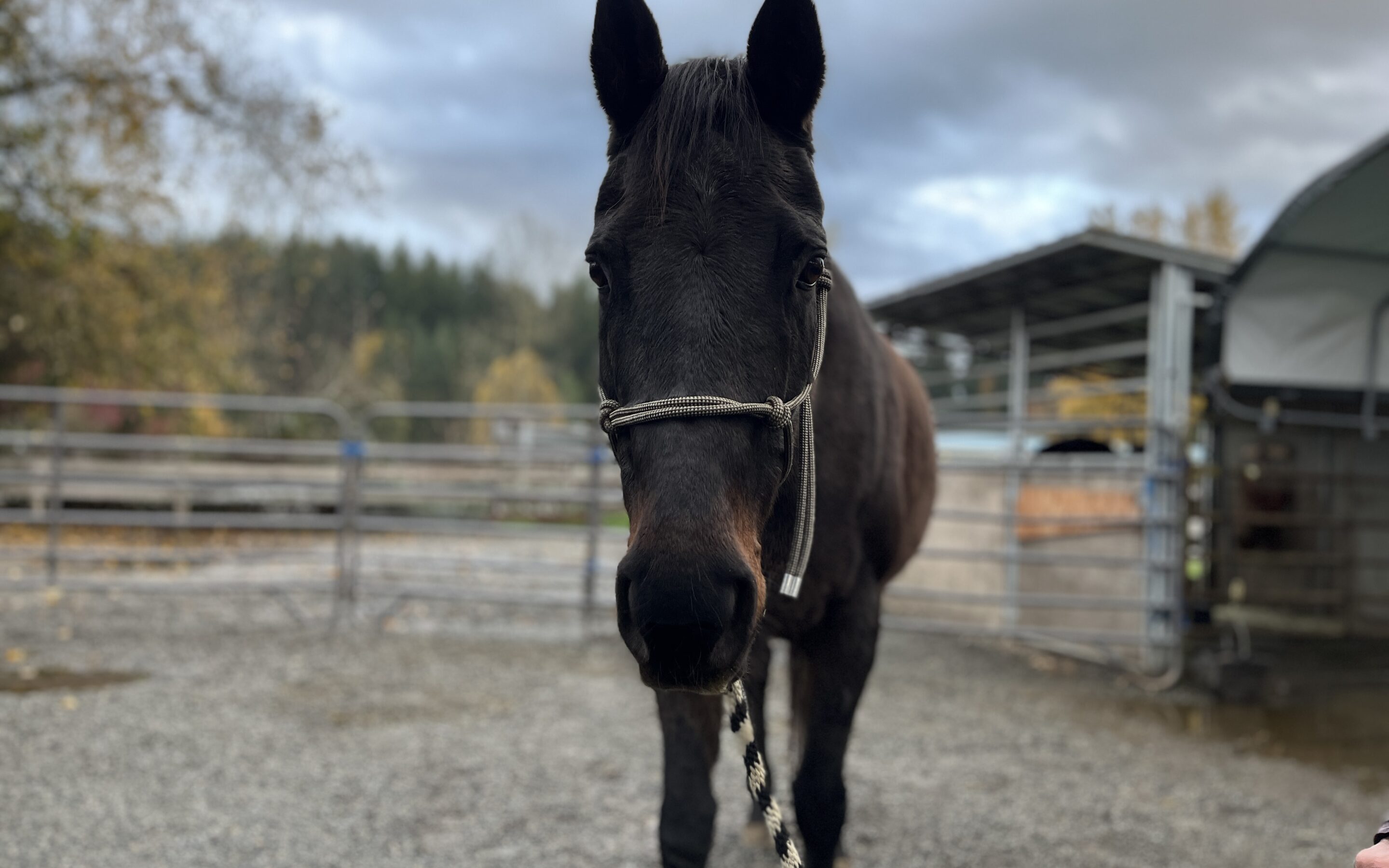
Introducing Dorothy
We welcomed Dorothy and Blanche (the Golden Girls, despite their dark coloration) into our herd last week, two ladies both seized by Pierce County Animal Control (they met for the first time on the trailer ride to SAFE, but were fast friends).
Dorothy is a 22 year old OTTB who, if we decoded her faded lip tattoo accurately, was born as ‘Jazz’n Off’ in 2001. She ran only once, at Portland Meadows, but decided that life as a race horse was not for her, as she stopped mid-way through the race. Her history becomes hazy after that, with no website keeping track of all that happened between the time she did not make it to the finish line to the time Pierce County Animal Control picked her up, nearly 20 years later, thin as a rail and in terrible shape. With a body condition score of 2, she would need to be put on a re-feeding program, something that is not only slightly nerve-wracking, but incredibly consuming as well, with small meals needing to be fed throughout the entire day (and sometimes through the night). Dorothy also had abscessing on all four feet, with her fronts being the worst offenders. She also was displaying signs of a UTI, which are uncommon in horses, but given the structure of Dorothy’s anatomy, seemed inevitable for her. But thanks to the great team at Tacoma Equine alongside her foster and the folks at Pierce County, Dorothy was able to get the help she needed. She was given a dental, and put on a more manageable grain diet when it was revealed she had a chronic wave mouth. She was seen by the farrier multiple times to help get her feet into better shape. She was given antibiotics for her infection and a few stitches to help keep manure out of places it shouldn’t be. She put on weight, and was given the care she had been previously denied. And this all before she stepped of the trailer at SAFE! We are, once again, so grateful for the PCAC and the wonderful fosters they work alongside — Dorothy’s case was one that required a hefty degree of management and time, but they did not give up on her. The horse who stepped off the trailer, while not fully rehabbed, was a far cry from the intake photos that Animal Control sent to us.
It just so happened that Dorothy’s intake coincided with a week when both our vet and farrier would be out. This sweet mare made these appointments a breeze. Despite the unfortunate condition of her feet (an improvement from where they had begun, but still a ways from healthy), Dorothy was a trooper for the farrier. It would have been more than understandable if she was to protest having her hooves handled, but she remained patient and kind throughout the trim. We put her in some nice cushy cloud boots for turnout with an artimud packing to help protect and heal her soles, and the addition of this extra cushion has really improved her comfort level.
Her chronic wave mouth will need further management, but she arrived at SAFE up to date on her vet care. The only thing left to do was remove the caslicks that had been placed to help prevent manure from entering into her vulva, causing further urinary tract issues. Despite being new to the barn and the property, she was a very brave lady.
Dorothy’s kind eye challenges you not to fall in love with her, and if it really is a challenge, then it’s one we are happy to fail. We look forward to continuing to nurse this lovely mare into the healthy and happy version of herself we know she can be!

